-
Paper Information
- Paper Submission
-
Journal Information
- About This Journal
- Editorial Board
- Current Issue
- Archive
- Author Guidelines
- Contact Us
Archaeology
2012; 1(2): 7-14
doi: 10.5923/j.archaeology.20120102.01
Raman Characterization of Gemstones from the Collection of the Byzantine & Christian Museum
Thomas Katsaros 1, Theodore Ganetsos 1, 2
1Byzantine & Christian Museum, Vas. Sofias, 22, 106 75, Athens, Greece
2T.E.I. Of Lamia, 3rd Km. Onr Lamia-Athens, Lamia, 35100, Greece
Correspondence to: Thomas Katsaros , Byzantine & Christian Museum, Vas. Sofias, 22, 106 75, Athens, Greece.
| Email: |  |
Copyright © 2012 Scientific & Academic Publishing. All Rights Reserved.
A very significant component of the collection of gold jewellery in the Byzantine Museum of Athens consists of the Mytilene Treasure from the island of Lesbos. Despite the importance of the Mytilene Treasure, one of the most significant hoards of the 7th century A.D. from the Aegean area, no previous systematic study has been dedicated to it since its discovery in 1951, except for brief entries in exhibition catalogues[Chalkia, 2008]. The presence of Gemstones among the artefacts, set us the question of their mineralogical identity. The samples which we study are the following BXM_875, BXM_872, BXM_178a, BXM_178b, BXM_873a, BXM_873b. The Raman spectroscopy measurements made in the Laboratory of Physicochemical Analysis of Byzantine & Christian Museum. The references on Gemstones in Byzantine literature are many and helpful[Stocchi M.,2009]. Theophrastus of Eressos mentions that exist a kind of false emerald[Caley, 1956]. In Christian Era Epiphanios of Cyprus is described in his text emeralds[Epiphanii Cypri, 4 cent.A.D.]. Another interesting reference is the book of Damigeron (1rst cent. A.D.) which includes a description of emerald[Tahil, 2005]. In Byzantine Era Michael Psellus (11nth c. A.D.) in his text De Virtutibus Lapidorum made a reference on emerald. In accordance to our experimental results: the BXM_872 contains nine real emeralds, the circular amulet BXM_875 is a blue glass with an addition of lapis lazuli, the earrings BXM_178a,b with the blue stones are not sapphires but they are possible a kind of glass paste and the earrings BXM_ 873a,b are green glass.
Keywords: Gemstones, Raman Spectroscopy, Jewellery, Emeralds, Lapis Lazuli
Cite this paper: Thomas Katsaros , Theodore Ganetsos , "Raman Characterization of Gemstones from the Collection of the Byzantine & Christian Museum", Archaeology, Vol. 1 No. 2, 2012, pp. 7-14. doi: 10.5923/j.archaeology.20120102.01.
Article Outline
1. Introduction
- A very significant component of the collection of gold jewellery in the Byzantine museum of Athens consists of the Mytilene Treasure from the island of Lesbos, Greece. Despite the importance of the Mytilene Treasure, one of the most significant hoards of the 7th century from the Aegean area, no previous systematic study has been dedicated to it since its discovery in 1951, except for brief entries in exhibition catalogues[1]. The presence of the gold jewellery in the hoard is a strong indication that this collection of objects belonged to a wealthy family and not to some Christian church, as was once maintained[2]. Some of the pieces, on account of their small size, seem to have been worn, not by adults, but by the children of the family. As in the Greco-Roman world, so in the Byzantine civilization, jewellery was not used simply for ornament. According to its value and type it could be a means of displaying wealth or social status, but it could also be talismanic. For example, the small gold disc (BXM_875) decorated with a cross (in the front side of the amulet is the cross and in the back side the cavity within the inclusion of the blue material) would have been worn on a chain round the neck not just to declare the owner's Christian faith but also to protect him or her from evil. The presence of gemstones among the artefacts set us the question of their mineralogical identity. The samples which we study are the following: (BXM_875), (BXM_872), (BXM_873a), (BXM_873b), and the (BXM_178a), (BXM_178b) not from the Mytilene Treasure, but from the main collection of Byzantine Museum. The Raman measurements were obtained in the Laboratory of Physicochemical Analysis of Byzantine & Christian Museum. The main purpose of the present research work is to identify by the using of a non destructive technique, such as Raman Spectroscopy, the coloured stones from the Museum Collections. The most ancient scientific work, described minerals and rocks, had written by the pupil and successor of Aristotle, in Lyceum, Theophrastus from Eressos. In the treatise, On Stones (315 B.C.), Theophrastus said that exist a kind of false emerald and a kind of melted lapis lazuli like glass paste[3] and give us more details on the manufacture of kyanos chytos as a product similar to the real thing (probably natural lapis lazuli), but which became after firing. In On Stones 55: those who write the history of the Kings of Egypt state which King it was who first made fused kyanos in imitation of the natural kind; and they add that kyanos was sent as tribute from Phoenicia and as gifts from other quarters, and some of it was natural and some had been produced by fire as translated by Caley (1956). Some inscriptions that have recently been discovered support the statement about the gifts and tribute of kyanos that were sent to Egypt, though they do not say that they came from Phoenicia. They say that tribute in the form of both natural and imitation lapis lazuli was sent by certain Mesopotamian rulers to Egyptian Kings[3]. In one of these inscriptions, for example, it is recorded that the ruler of Assur sent as tribute to Tuthmosis the 3rd three large lumps of genuine lapis lazuli and three pieces of "blue stone of babel," which was apparently an imitation. So the problem of the nature of lapis lazuli dated since the antiquity. We don’t know, how the ancients (Egyptians or Greeks) were testified the authenticity of a real lapis lazuli stone. The references of gemstones in Byzantine literature are many and helpful[4-5]. In proto-Christian Era Epiphanios of Cyprus (4 cent. A.D.) describes in his text The 12 gemstones on the breastplate of the high-priest Aaron and among these the emerald[6]. The specific term of emerald is now but a general trade designation, for various green precious and semi-precious stones and not, in the jewellery trade. The use of a general non mineralogical term such as smaragdos (for emerald) in antiquity was to characterize more minerals except the real beryl’s variety emerald. Another earlier interesting reference on the power of gemstones is the book Virtutibus Lapidorum of Damigeron (1rst cent. A.d). This book includes descriptions of emeralds and lapis lazuli, in accordance to a different point of view, because this text belongs to a non scientific tradition of Orpheii Lithica[7]. A thousand years later in Byzantine era Michael Psellus (11th c. A.D.) in his text de De Virtutibus Lapidorum made valuable regarding on emerald and sapphire respectively[8]. The case of a kind of manufactured lapis lazuli’s like material, such as noted for the first time by Theophrastus of Eressos is a new technological question. Would be prepared by the ancient metallurgists, using fire techniques, an artificial analogue to the natural lapis lazuli or not? And if this hypothesis was real, how can we decide on the nature of these two materials, the natural one, and on the other hand the artificial? The addition of natural lapis lazuli in a blue glass related with this hypothesis and how?
2. Experimental Results and Discussions
- Raman spectra obtained by a portable spectrometer (Rockhound 785nm DeltaNu) and were recorded in the range of 200 – 2000 cm-1. we examined the optical properties of these artifacts using Raman spectroscopy, with a high resolution of 10 cm-1 and low signal to noise. This is a light-scattering and non-destructive technique which allows for the identification[9] by comparing a spectrum to a mineral database of the RRUFF-Project[10]. All the Raman analytical results have been normalized by baseline program. The first question was about the identification of the 9 green stones, if they are real emeralds or not. We made Raman measurement to testify the stones on the necklace (BXM_872), and additional measurements from the (BXM_873, BXM_875) respectively. We used the Origin Lab. Program to present our analytical results. In the case of the necklace (BXM_872) (see fig.9) the spectra lines of the nine green stones overlapping each other, and testified as natural emerald in accordance to the comparison (see fig.3) to the reference Raman spectra from a natural emerald from Pakistan (Swat Valley) of RRUFF Database[10]. These bands are the so-called main Raman bands of emerald, in which bands around 321-325 cm-1, 395-398 cm-1 and 683-688 cm-1 have been assigned to ring vibrations by all investigators[11-15]. About the investigation of provenance of emerald the evaluation of o16 to o18 is a helpful technique for further research in the future[16]. The golden earrings (BXM_178a, BXM_178b) which not included in Mytilene Treasure were testified (see fig. 8) as blue glass and not as natural sapphire (table 1). We observe the similar vibrations which belongs to the presence of lapis lazuli at 530 cm-1 and 547 cm-1 (table 1). The spectra of fig.2 show the difference between our analytical Raman results to the Raman spectra of natural sapphire from Sri Lanka[10]. The golden amulet (BXM_875) with the blue included material in the middle, identified as a glass with addition of Lazurite[17]. We have a data bank of natural mineral samples of lapis lazuli from different localities of Afghanistan. The component of the blue material in the golden amulet (BXM_875) possibly came from the region of Regi mine (Northern Afghanistan). This hypothesis needs the contribution of one more technique for supporting, such as μ-XRF to investigate some trace elements as fingerprint of its geological provenance. We took 2 measurements from the object BXM_875 (see fig.4) in this case the characteristic strong peak appeared at the region of 1315 cm-1 which is corresponded to the peak at 1313 cm-1 of silicon bond of lapis lazuli[18-19]. We have the well known information on the case of lapis lazuli’s imitation, by fire process, since the Hellenistic period (Theophrastus of Eressos 4th c B.C.). This kind of blue material, with the addition of natural lapis lazuli, is proofed with the application of Raman spectroscopy by two different researchers: one sample dated in the second century A.D. from southern Poland[20] and the other from Iran which dated in the middle of 14th c. A.D.[21-22]. These papers clarified that the lapis lazuli had played a role of opacifier material of the glass. The ancient glassmakers invented this method, as mentioned by Theophrastus, to imitate the original rock, because a common cobalt blue glass has a different hue to the real lapis lazuli and different transparency. Our analytical Raman results from the amulet of Kratigos of Mytilene (7th c. A.D.) cover the absence in the chronological gap, between the first written reference by Theophrastus and the later archaeological remains, which studied by Philippe Colomban and Susanne Greiff respectively. The investigation of the technique of sintering of a blue material relative to lazurite above of a cobalt blue glass is open to experimental archaeology. We propose that the Art of Chymeutiki (Berthelot and Ruelle 1888)[24] in Byzantine era possibly related to the creation of a lapis lazuli’s analogue material. The characteristic Raman peaks at 530 cm-1[17] and 1315 cm-1 in the sample (BXM_785) (see fig.4) identified as lazurite, after comparison to the data from bibliography (table 1). On the other hand the material of the amulet (BXM_875) (see fig.7) is not a natural rock, because of the existence of the gas holes in its body. The experimental results of the golden earrings (BXM_873a, BXM_873b) (see fig.6) not give us a positive characterization, because of the strong fluorescence (see fig.1).
 | Figure 1. Raman spectra of the green stones of the earrings BXM_873a, BXM_873b. The strong fluorescence not allowed identifying the material |
 | Figure 2. Raman spectra of the golden earrings BXM_178a, BXM_178b with the blue stones in comparison to the natural corundum (blue sapphire from Sri Lanka) from the RRUFF Databse |
 | Figure 3. Raman spectra of an emerald sample from Pakistan (RRUFF) and the green stone from the necklace BXM_872_2 of Byzantine Museum. The behaviour of the spectra is very similar and at the region of 323 cm-1 and we observe the equal characteristic band |
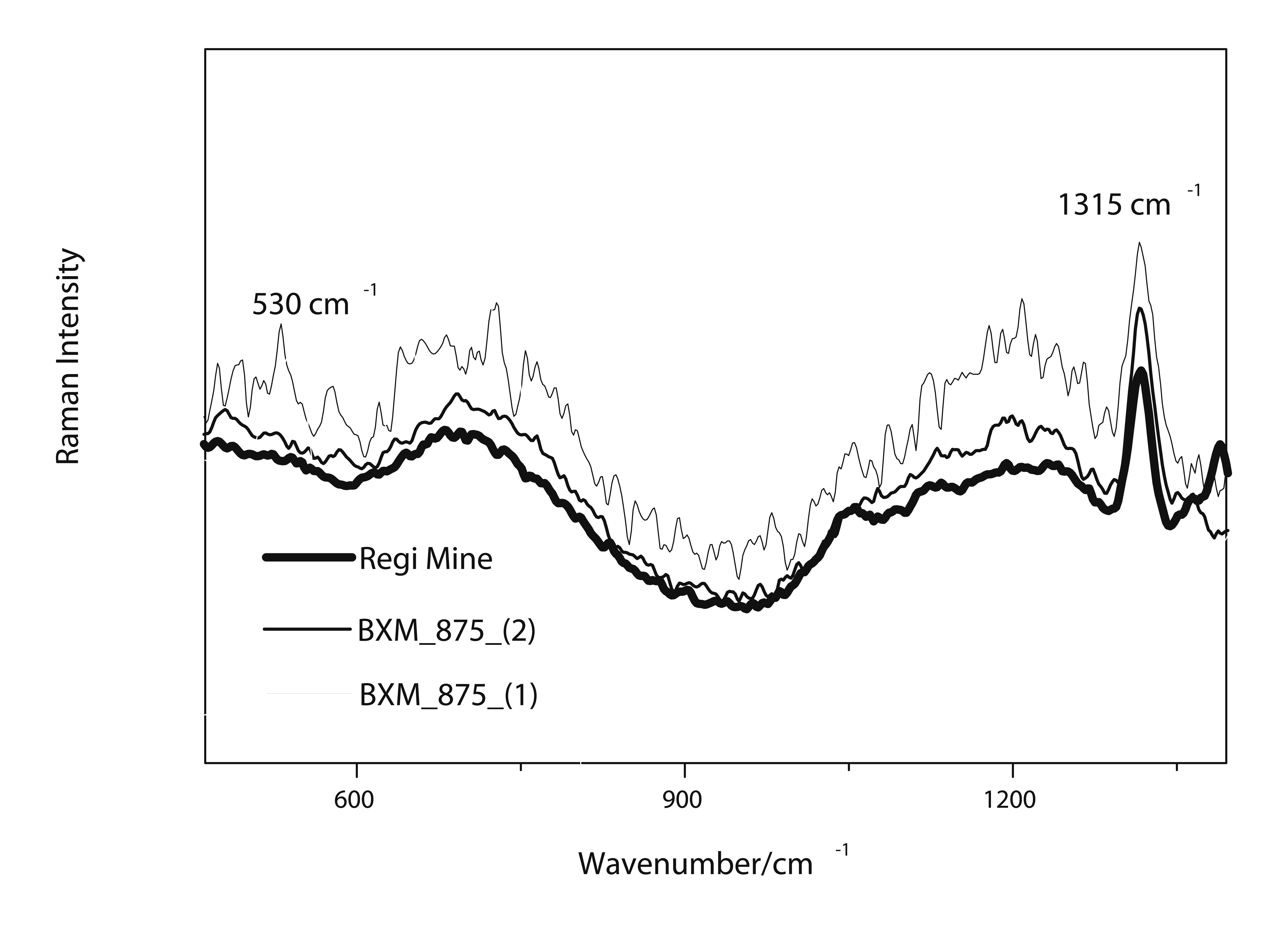 | Figure 4. Raman spectra of the golden amulet BXM_875_1,2 with the blue fragments inside, in comparison to a geological sample of lapis lazuli from Regi mine of Afghanistan. We can observe the characteristic peak at 530 cm-1 for lapis in the sample BXM_875-1, additionally the main characteristic peak at 1315 cm-1 for all the spectra curves |
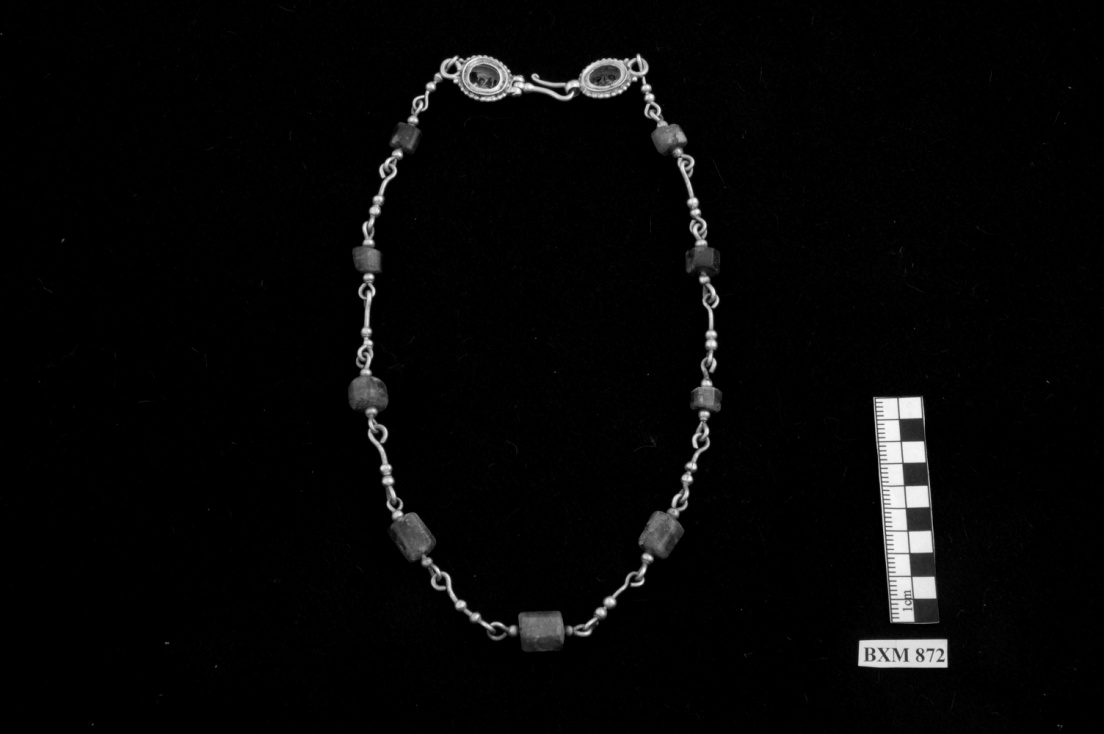 | Figure 5. The necklace BXM_872 with the nine green stones of the Byzantine and Christian Museum |
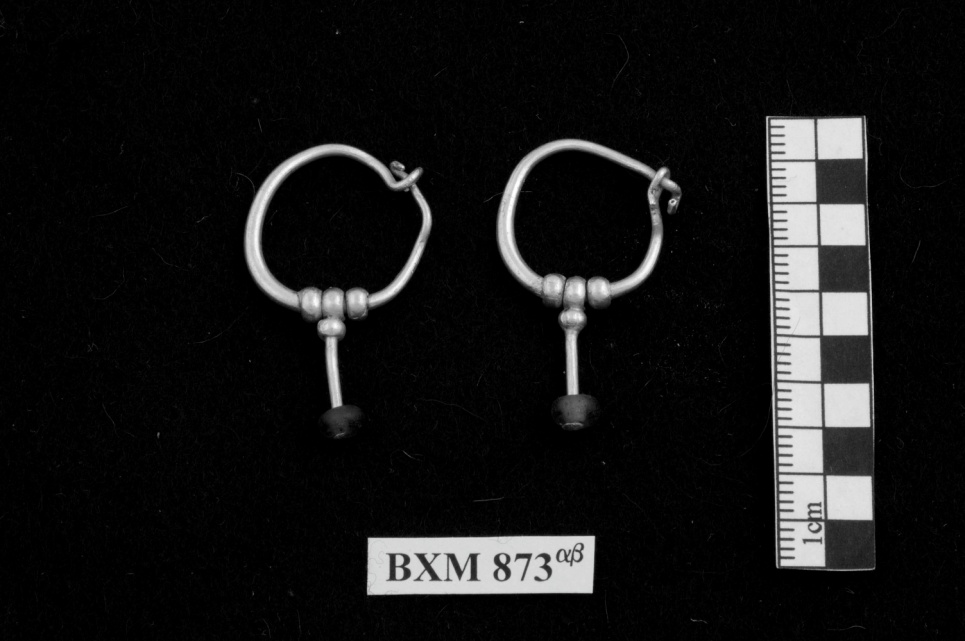 | Figure 6. The golden earrings BXM_873a,b with the green glass from the Byzantine Museum |
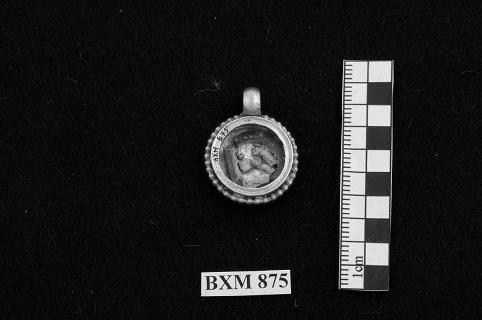 | Figure 7. The golden amulet BXM_875 with the blue glass-like fragments inside |
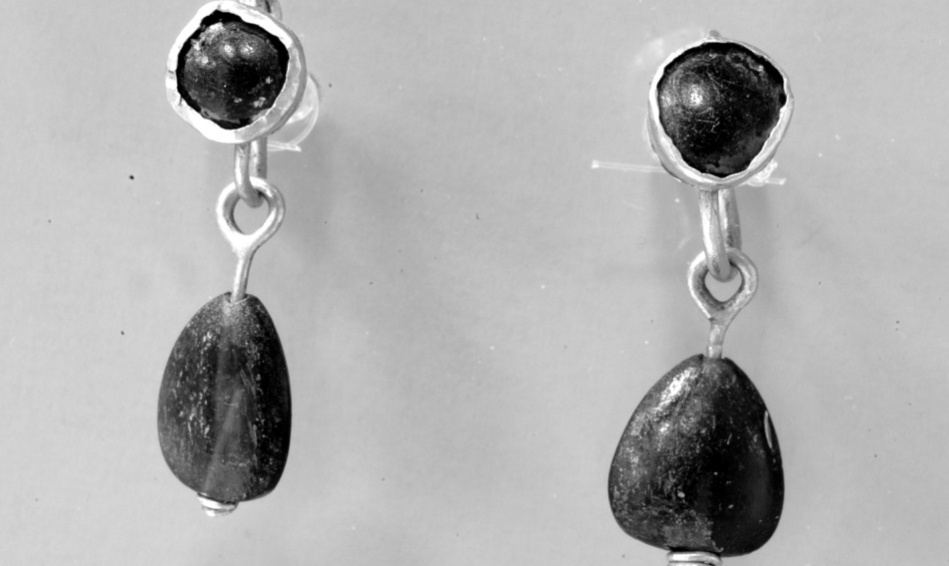 | Figure 8. The golden earrings BXM_ 178a,b with the blue beads which had previously referred as sapphires |
 | Figure 9. All the Raman spectra of the nine green stones from the necklace BXM_872 are setting in comparison with each others. We have the characteristic Raman bands at the two areas of 323cm-1 and 686 cm-1 |
3. Conclusions
- The application of Raman spectroscopy is a rapid and successful technique to investigate gemstones; additionally the non destructive character of this method is the only way to resolve problems on archaeological objects. We apply Raman spectroscopy to testify 9 green stones on the necklace (BXM_872) the green beryl, excepting in its colour, is the same mineral as aquamarine. One of the rarest of gems is a flawless emerald-hued beryl[23]. In accordance to our experimental results: the golden necklace (BXM_872) contains nine natural emeralds; the circular golden amulet (BXM_875) includes a blue glass which contains lazurite as opacifier. Another reason of the presence of lazurite in blue glasses probably related with a magical practice. The observation that lazurite was used as a pigment in a glass flux on vessels from Roman period context sheds a new light on the development of the manufacturing techniques of enameled glasses in antiquity[20]. The as yet earliest evidence for its application in a high temperature process seems to fall into the 13th century with a lazurite rich slip under a cobalt glaze on an Iranian ceramic ewer (Colomban 2003). Our experimental result for (BXM_875) is an evidence for the use of lazurite in Byzantine Empire as an opacifier agent on enameled glass, at the 1st decade of 7th century A.D. The golden earrings (BXM_178a,b) with the blue stones are not sapphires, but they are possible a kind of blue glass with an addition of lazurite (see table 1) and the golden earrings from Mytilene Treasure (BXM_ 873a,b) are green glass.
ACKNOWLEDGEMENTS
- The authors would like to express their special thanks to the TEI of Lamia for supporting to this research work. Additionally, we would like to thanks the present Director of the Byzantine and Christian Museum (2012) Dr. Anastasia Lazaridou and for the use of the photographs of the jewells from the Byzantine Museum Photograph Archives.
References
| [1] | E. Chalkia, the catalogue of Byzantine and Christian museum, the Byzantine collections, Byzantine museum press, Athens, 2008. |
| [2] | I. Touratsoglou, E. Chalkia, The Kratigos, Mytilene Treasure, coins and valuables of the 7th century A.D., Byzantine Museum Press, Athens, 2008. |
| [3] | R. Caley, I. Richards, Theophrastus On Stones, introduction Greek text English translation and commentary, Ohio state univ. Press, Chicago, 1956. |
| [4] | M. Stocchi, The treasury of Saint Peter’s in the Vatican, Capitolo Vaticano press, Rome, 2009. |
| [5] | I. Spier, Late Antique & Early Christian Gems, Verlag, Wiesbaden, 2007. |
| [6] | Epiphanii Episcopi Salamis Cyprii, De XII Gemmis, Aegean University Press, www.aegean.gr/culturaltec/chmlab, 2008. |
| [7] | P. Tahil, Damigeron, The Virtues of Stones, (Eds: J. Radcliffe) Ars Obscure, Seattle, 2005, pp.14-15. |
| [8] | Michael Constantine Psellus, De Lapidus, Julius Ludwig Ideler, 1841-42. |
| [9] | Th. Katsaros, I. Liritzis, Tr. Thompson, K. Carron, Geol. Soc. of America - proceedings of Denver Annual meeting. 2007; 39 , 574. |
| [10] | R. T. Downs, program and abstracts of the 19th general meeting of the international mineralogical association. 2006; 3. |
| [11] | I. Moroz, M. Roth, M. Boudeulle, G. Panczer, Journal of Raman Spec. 2000 ; 31, 1502. |
| [12] | D. M. Adams, I. R. Gardner, Journal of Chem. Soc. 1974 ; 1502. |
| [13] | W. P. Griffith, G. Morteani, Journal of Chem. Soc. 1969 ;1372. |
| [14] | B. Charoy, P. De donato, O. Barres, C. Pinto-Coello, American mineral. 1969 ; 81, 395. |
| [15] | C. Kim, M. I. Bell, D. A. MacKeown, Physica b, 1995 ; 205, 193. |
| [16] | G. Giuliani, M. Chaussidon, H. J. Schubnel, D. H. Piat, Cl. Rollion-bard, Chr. France-lanord, D. Giard, D. De Narvaez, B. Rondeau, Science, 2000 ; 287 , 631. |
| [17] | I. Th. Th. Huong, Microscopic, chemical and spectroscopic investigations on emeralds of various origins, Ph. D. Thesis - University of Mainz Press, 2008. |
| [18] | I.Burgio, R. J. H. Clark, Spectr. Acta, 2001 ; 57, 1491. |
| [19] | K. L. Brown, r. J. H. Clark, , Journal of Raman Spec. 2004 ; 35 , 4. |
| [20] | S. Greiff, I. Schuster, proceedings in 17th annual v.m. Goldschmidt conference in Cologne ; 2007, 353. |
| [21] | Ph. Colomban, Journal of Raman Spec. 2003 ; 34, 420. |
| [22] | Ph. Colomban, Appl. Phys. A, 2004 ; 79, 167. |
| [23] | I. A. Wodiska Book of Precius Stones, New York, 1910. |
| [24] | M. Berthelot, Em. Ruelle, Collection des Anciens Alchimistes Grecs, Paris, 1888 (in Frances). |
 Abstract
Abstract Reference
Reference Full-Text PDF
Full-Text PDF Full-Text HTML
Full-Text HTML